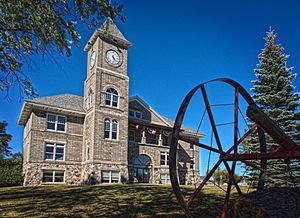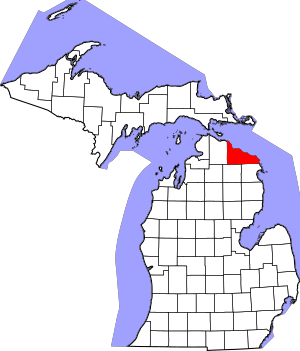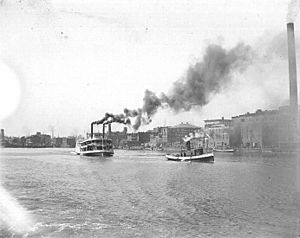Presque Isle County, Michigan facts for kids
Quick facts for kids
Presque Isle County
|
||
|---|---|---|
 |
||
|
||

Location within the U.S. state of Michigan
|
||
 Michigan's location within the U.S. |
||
| Country | ||
| State | ||
| Founded | 1840 (created) 1871 (organized) 1875 (reorganized) |
|
| Seat | Rogers City | |
| Largest city | Rogers City | |
| Area | ||
| • Total | 2,573 sq mi (6,660 km2) | |
| • Land | 659 sq mi (1,710 km2) | |
| • Water | 1,914 sq mi (4,960 km2) 74% | |
| Population
(2020)
|
||
| • Total | 12,982 | |
| • Density | 20/sq mi (8/km2) | |
| Time zone | UTC−5 (Eastern) | |
| • Summer (DST) | UTC−4 (EDT) | |
| Congressional district | 1st | |
Presque Isle County ( PRESK-eel) is a county in the Lower peninsula of the U.S. state of Michigan. As of the 2020 Census, the population was 12,982. The county seat is Rogers City. The county was authorized by state legislative action on April 1, 1840, but the county government was not established until 1871. The government was reorganized in 1875.
Both the county and Presque Isle Township are named for Presque Isle (French, "almost an island"; the term for a narrow peninsula). A large part of the township consists of that peninsula, with Lake Huron on the east, Grand Lake on the west, and narrow strips of land connecting it to the mainland at the north and south ends. The community of Presque Isle is near the center of this peninsula.
Contents
History
Early Native Americans living in the area were nomadic, using the land as hunting grounds. To them the land between the Ocqueoc and Swan Rivers was sacred ground. The name "Presque Isle" was given to the area by fur traders who portaged over the strip of land that attaches Presque Isle to the mainland.
Early development of the area was delayed because it had no navigable river. The Ocqueoc River was Presque Isle's largest river but it was shallow and crooked, with many rapids. In the spring of 1839 a surveying party, contracted by the state of Michigan, reported that the land of this area was worthless. This further discouraged development until the 1860s when the Crawford family settled into a quiet cove of Lake Huron, south of present-day Rogers City. They intended to develop a stone quarry, but found the stone too flaky to be used as building material. Turning to lumbering, they sold the wood to steamers traveling the Great Lakes.
In 1868 W.E. Rogers, an Army officer, organized a surveying party to Presque Isle, with Albert Molitor as supervisor. Seeing the huge forests, they attempted to purchase Crawford's Quarry but were refused. They formed the Molitor-Rogers Company purchasing the land at the site of Rogers City. The following year a large party of German and Polish immigrants arrived and began settling in the area. The Molitor-Rogers Company built a sawmill, store, boarding house, and blacksmith shop. The small city was solely supplied by the company. After a difficult winter in 1870-71, the community began to thrive.
The original settlers of this county were lumbermen, fishermen and farmers. In 1907 a mining engineer/geologist from New York, H.H. Hindshaw, visited Crawford's Quarry and found it to be rich in limestone. Following this discovery, the Michigan Limestone and Chemical Company of Calcite, Michigan, was founded. The company purchased 8,000 acres (32 km2) at Calcite, the new name for Crawford's Quarry. Recognizing the need for a means of shipping their product, the Bradley Transportation Company was formed. The company is known in the area for being the chief business, employing a significant portion of the area's residents. One of the darker aspects of the county's history involved the Bradley Transportation Company when one of their cargo ships, the Carl D. Bradley sank on Lake Michigan during a windstorm in November 1958 with the loss of 33 lives, 29 of whom resided in Presque Isle County (26 were from Rogers City, two were from Onaway, and one was from Metz Township).
Today the world's largest limestone processing plant is located in Rogers City, which is also a major Great Lakes Port. This is the best natural harbor on Lake Huron between Port Huron and Mackinaw City.
Geography
According to the U.S. Census Bureau, the county has a total area of 2,573 square miles (6,660 km2), of which 659 square miles (1,710 km2) is land and 1,914 square miles (4,960 km2) (74%) is water. It is considered to be part of Northern Michigan.
Geographic features
- Grand Lake (Presque Isle, Michigan)
- Ocqueoc Falls [1] (Ocqueoc Township, Michigan)
Adjacent counties
- Chippewa County (north)
- Manitoulin District, Ontario (east)
- Alpena County (southeast)
- Montmorency County (southwest)
- Cheboygan County (west)
- Mackinac County (northwest)
Transportation
Air
There is one county-owned airport in Presque Isle County, providing access to general aviation:
- Presque Isle County Airport – located SW of Rogers City
The nearest commercial airline airports are Alpena County Regional Airport near Alpena, and Cherry Capital Airport near (Traverse City).
Major highways
 US 23
US 23
 Bus. US 23
Bus. US 23 M-33
M-33 M-65
M-65 M-68
M-68- M-211
 F-21
F-21
Demographics
| Historical population | |||
|---|---|---|---|
| Census | Pop. | %± | |
| 1860 | 26 | — | |
| 1870 | 355 | 1,265.4% | |
| 1880 | 3,113 | 776.9% | |
| 1890 | 4,687 | 50.6% | |
| 1900 | 8,821 | 88.2% | |
| 1910 | 11,249 | 27.5% | |
| 1920 | 12,131 | 7.8% | |
| 1930 | 11,330 | −6.6% | |
| 1940 | 12,250 | 8.1% | |
| 1950 | 11,996 | −2.1% | |
| 1960 | 13,117 | 9.3% | |
| 1970 | 12,836 | −2.1% | |
| 1980 | 14,267 | 11.1% | |
| 1990 | 13,743 | −3.7% | |
| 2000 | 14,411 | 4.9% | |
| 2010 | 13,376 | −7.2% | |
| 2020 | 12,982 | −2.9% | |
| US Decennial Census 1790-1960 1900-1990 1990-2000 2010-2018 |
|||
As of the 2000 United States Census, of 2000, there were 14,411 people, 6,155 households, and 4,203 families residing in the county. The population density was 22 people per square mile (8/km2). There were 9,910 housing units at an average density of 15 per square mile (6/km2). The county's racial makeup was 98.07% White, 0.26% Black or African American, 0.59% Native American, 0.16% Asian, 0.01% Pacific Islander, 0.09% from other races, and 0.82% from two or more races. 0.55% of the population were Hispanic or Latino of any race. 28.5% were of German, 28.2% Polish, 7.9% English, 6.3% American, 5.6% French and 5.6% Irish ancestry. 95.7% spoke English and 3.1% Polish as their first language.
There were 6,155 households, of which 24.50% had children under age 18 living with them, 58.80% were married couples living together, 6.30% had a female householder with no husband present, and 31.70% were non-families. 28.40% of all households were made up of individuals, and 14.50% had someone living alone who was 65 years of age or older. The average household size was 2.31 and the average family size was 2.80.
The county population contained 20.90% under the age of 18, 6.50% from 18 to 24, 22.40% from 25 to 44, 27.80% from 45 to 64, and 22.30% who were 65 years of age or older. The median age was 45 years. For every 100 females there were 99.20 males. For every 100 females age 18 and over, there were 97.10 males.
The median income for a household in the county was $31,656, and the median income for a family was $37,426. Males had a median income of $31,275 versus $20,625 for females. The per capita income for the county was $17,363. About 6.80% of families and 10.30% of the population were below the poverty line, including 13.10% of those under age 18 and 9.20% of those over age 64.
Historical markers
There are ten recognized Michigan historical markers in the county:
- Bearinger Union School
- Burnham's Landing
- Elowsky Mill
- Forty Mile Point Lighthouse / Graveyard of Ships
- Lake Huron
- The Metz Fire
- Old Presque Isle Lighthouse
- Presque Isle Electric Cooperative Monument
- Presque Isle Light Station
- World's Largest Limestone Quarry
Communities
Cities
- Onaway
- Rogers City (county seat)
Villages
Census-designated place
Other unincorporated communities
Townships
- Allis Township
- Bearinger Township
- Belknap Township
- Bismarck Township
- Case Township
- Krakow Township
- Metz Township
- Moltke Township
- North Allis Township
- Ocqueoc Township
- Posen Township
- Presque Isle Township
- Pulawski Township
- Rogers Township
Images for kids
-
U.S. Census data map showing local municipal boundaries within Presque Isle County. Shaded areas represent incorporated cities.
See also
 In Spanish: Condado de Presque Isle para niños
In Spanish: Condado de Presque Isle para niños




